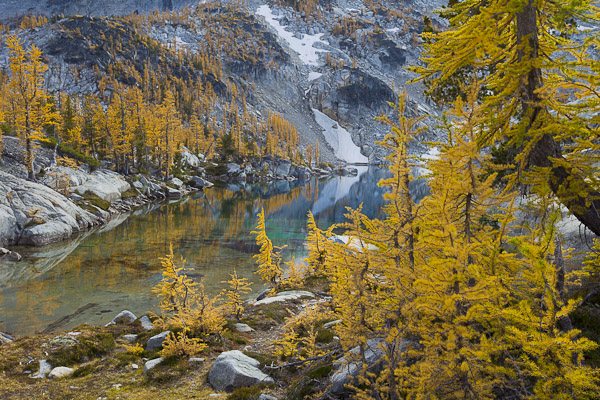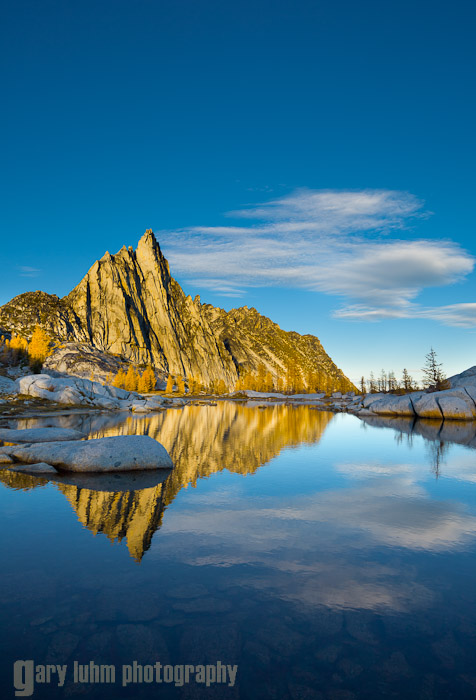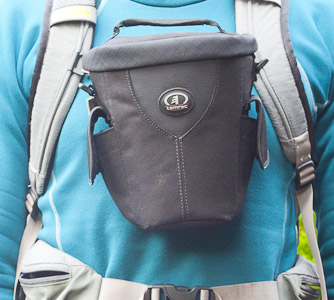I survived our Enchantments backpack trip. OK, maybe better than survived. I feel more like I thrived, despite the 4,400 ft vertical climb the first day over Aasgard Pass. The thriving resulted from getting in shape, and cutting the gear load. The eye-popping, golden-larch and granite spire landscape-that-rivals-Yosemite might be a factor. Maybe.

Washington’s Alpine Lakes Wilderness Enchantments is a pinnacle of North Cascades backpacking. It’s tough however you get there, so getting there involves commitment. In 1995—my first Enchantments trip—I carried a pack weight of 55 lb (5 days), including 10 lb of camera gear, up and over Aasgard Pass. This trip my pack weighed 37 lb (also 5 days), including 8.2 lb camera gear. I also carried a 4.5 lb two-person tent, and my travel buddy carried the stove, fuel and pot. Overall, I think with the lighter load I was still better equipped. The 18 lb difference made the trip easier, more fun, and more productive photographically.You can view select 2010 Enchantment images at: http://www.garyluhm.net/lightroomwebstuff/enchantments_2010/.
Photographers need to lighten their load, without sacrificing image quality. So my Canon 5D II, tripod and L-series lenses are an uncompromising go. Last year I wrote about light-weight backpacking photography in the 2009/10 tip. I’ve since made changes in sleeping system, pack and other areas.
Sleeping System: The big change here isn’t a weight reducer but a choice for comfort. Since last spring I’ve been sleeping on an air mattress, the Thermorest NeoAir (14 oz, 72×20”). It’s unique for air mattresses, hitting a triple with compact packed size, light weight and decent R-value (2.5). I can’t call it a four bagger, though—it costs a lot. I’ve slept on it dozens of nights down to 28F, and it’s made a difference in getting a good night’s sleep. For shoulder seasons, I think it’s marginally warmer than a standard 1” Thermorest, with more comfort and the same or even lighter weight. I haven’t had any problems with the mattress deflating, or with punctures. Just in case, it’s a good idea to carry a patch kit. A deflated mattress could be cold, hard and miserable.

Pack: I finally got my pack volume down to where I could manage with a GoLite Jam pack, 3,000 in3, 32 oz. It’s a full four-pounds lighter than my old, much-bigger-volume Gregory. The GoLite Jam is light-weight, no frills and just meets the need. It’s good for carrying up to 35 lb, and I’ve found the lowish volume keeps me focused on getting under 30 lb for a three-night trip.
Clothing: My one clothing change worth noting is a Pendleton merino wool shirt, 7.2 oz, warm and so superior to polypro (or capilene) for the smell factor that I can’t imagine anything better. After four or five days in the field, rinse it in a stream and you’re good to go again. I’m also very pleased with my year-old Montbell Ex Light down jacket (5.7 oz). It packs to the size of a softball and replaces my 22 oz fleece jacket.
Water Treatment: My MSR Hyperflow water filter, in the carry sack, weighs 9 oz (listed weight is 7 oz). It replaces my 13 oz Katadyn Hiker (listed 11 oz). After a season of moderately-heavy use, I’d say it pumps fast, faster than the Katadyn, if a bit hard. I never experienced clogging problems, but I always pumped from water that looked clear. It’s also quite compact.
Food: I count calories on most trips, and the longer the trip the more important that becomes. I’d rather not carry extra food beyond half-a-day, my emergency cushion. I estimate 3,200 calories a day and 110 cal/oz, so that’s 29 ounces or 1.8 lb food/day. Many items fuel up around 100 cal/oz, like pasta, crackers, cheese, dried milk and salami. I use cashews, macadamia and pine nuts (and buttery deserts like Walker shortbread) to up the calories and offset dried vegetables, dried fruit and the rare fresh fruit (like the apple that really hits the spot at day three).

Camera Gear: We’re doing all this light-weight stuff to get us into the wilderness in better shape to capture images. This applies to camera gear as well. Here’s my current light-weight camera bag solution:
For the long trek, I’m using a Tamrac 3330 Aero Zoom 30, 7 oz, and at $25, a just-right bargain. My Canon 5D II with a 17-40mm f/4L lens attached, and lens hood reversed, fits snuggly. The Zoom 30 has two minimalist side pouches. In one I put extra flash cards. In the other I wrap a shower cap around a 77mm polarizing or ND filter (normal-sized plastic or padded filter cases won’t fit). There isn’t room for more. I carry the Tamrac simply but effectively, by slipping the Golite pack’s chest strap through the bag’s belt loop. This makes it instantly accessible for grab shots while hiking, and it unloads the pack of some volume, useful when on late-season trips for packing a warmer sleeping bag and more clothes.
Gary